|
Home of
10 South Carolina Governors
|
|
|
|
|
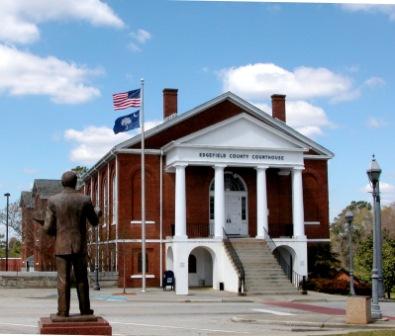
Edgefield County Court House.
The site of the court house for Edgefield County was first chosen in 1785. A “gaol” was built here as early
as 1785. The original court house, a weather-boarded building constructed in 1787 – 1788, is believed to have
been located in the center of the “Publick Lot.” It was not until 1792 that Arthur Simkins, one of the Judges
of the County Court, acquired title to this property and then deeded to the “Honorable Judges of the County Court”
two and a quarter acres “whereon the Court House and Jail now stand.” A second court house built of brick,
circa 1809, was improved by Robert Mills with the addition of porticos on either side in 1826. The present court house,
our third one, was completed in 1839. Although it was not designed by Robert Mills who had already gone to Washington,
it was certainly “inspired” by him as it was designed and constructed by his longtime protégé, Charles
Beck, and includes more of the distinctive Mills features than almost any court house designed by Mills himself. In
an 1839 editorial, the Edgefield Advertiser noted that the new court house “is a large and noble looking building
. . . . It may be truly said that the style of the building is chaste and that it is an ornament to the village.”
|
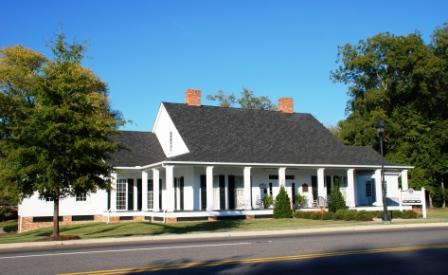
The Discovery Center.
The Joanne T. Rainsford Discovery Center of the South Carolina National Heritage Corridor was built in 1840 by Captain James
Miller, a wealthy planter and captain of an Edgefield militia company. It was moved in 1992 from its original location
some seven miles south of Edgefield on U.S. Highway 25 to its Main Street location in Edgefield. The original house,
prior to being moved, had heavy plaster moldings, unique painted designs on the ceilings and a second-floor ballroom.
When reconstructed after its move to Edgefield, the ballroom was not reproduced and changes were made to make the house more
suitable for a museum. The house, which had been known as “Magnolia Grove” prior to its removal, was renamed
in memory of Joanne T. Rainsford (1949-1997), the president of the Edgefield County Historical Society and one of the founders
of the South Carolina National Heritage Corridor.
|
|
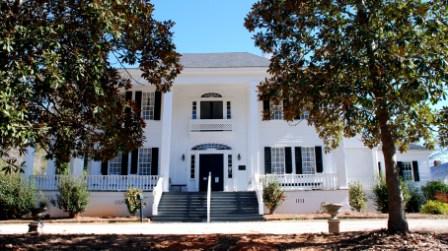
Oakley
Park. Built in 1835 by Daniel Bird, a prominent planter who had a special interest in architecture, Oakley
Park was acquired by Col. Marshall Frazier in 1840. He lived there until his death in 1870. Several years later it was
purchased by General Martin Witherspoon Gary, a former Major-General of the Confederacy. It was used as his headquarters
in 1876 when he was the leader of the Red Shirt movement, a campaign to restore Democratic government to South Carolina.
After Gary’s death in 1881, it was home to various members of his family until 1941 when Gary’s nephew, Governor
John Gary Evans, gave the property to the Town of Edgefield and the United Daughters of the Confederacy. Today, Oakley
Park is a house museum and is open to the public.
|
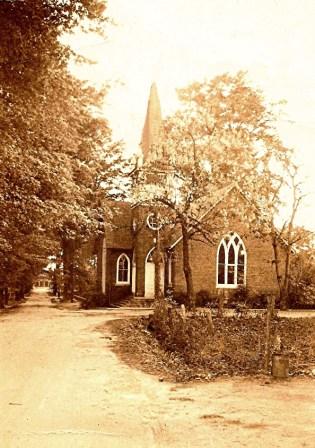
Edgefield Methodist Church.
Although there had been Methodist services in Edgefield as early as 1790, and there had been a Methodist Church at Pottersville
as early as 1820, the first Methodist Church in Edgefield was organized about 1830 and the first church building erected
in 1831. This first church was located on the Cambridge Road (now Buncombe Street) about a half-mile from the Court
House between the Adams-Mims House and Holmewood. In 1839 and 1841 property closer into town, between Main Street and
the present Norris Street, was acquired for a new building which was constructed at that time. The Rev. Joseph Moore,
an early Methodist minister who had done much to help build Methodism in Edgefield, donated this land for the Church.
In 1891 & 1892 the present building was constructed on the corner of Norris and Bacon Streets. The old church building
which faced Bacon Street was converted into a parsonage and remained there until 1957 when it was torn down and the present
parsonage constructed
|
|
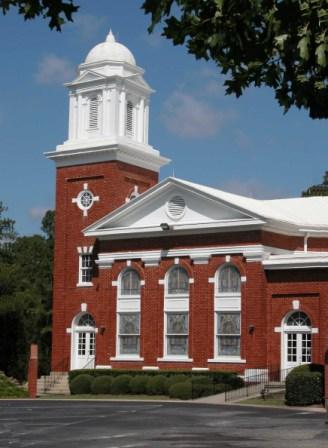
Edgefield Village (First) Baptist Church.
Organized in 1823, this church has been one of the most influential churches in South Carolina. It was in this church
in 1826 that Furman University was conceived and founded. The land for the church was given by Eldred Simkins with a
broad subscription from all over the county. The first moderator was Arthur Simkins, the first clerk, Matthew Mims,
and the first pastor, Basil Manly. Later pastors of note include William Bullein Johnson, founder and first president
of the Southern Baptist Convention, Luther R. Gwaltney and Dr. Robert G. Lee, who first wrote and delivered his famous sermon
“Payday Someday” while he was here. Dr. John Lake (1870-1949), ordained in this church, went on to become
a missionary to China where he founded the Tai-Kam Leper Colony. The 1823 church building was a wooden structure which
was torn down in 1889. A second building was erected of brick in that year, but it was struck by lightning and burned
in 1913. The present church was built in the following year
|
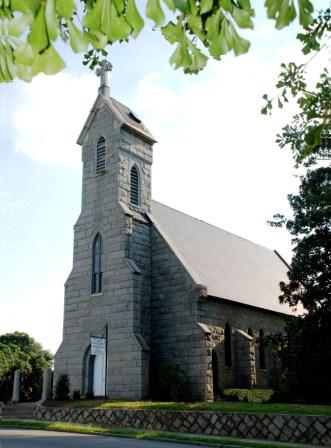
St. Mary of the Immaculate Conception
Catholic Church and Cemetery: Built between 1858 and 1860, primarily through the efforts of Father Timothy
Bermingham, a native of Ireland, this church had the support of a number of prominent Edgefieldians, including Dr. John Harwood
Burt and Dr. Elbert Bland. It was designed by Mr. John Rudolph Niernsie (1831-1885), the architect of the State House
in Columbia, and built out of local granite by itinerant stonecutters and masons, under the supervision of Mr. Pat Whelan,
foreman. The altars were imported from Italy. The church is one of the most significant structures of its kind
in South Carolina. The adjacent cemetery contains the graves of several Confederate soldiers, including that of Dr.
Harwood Burt, the father of Catholicism in Edgefield County.
|
|
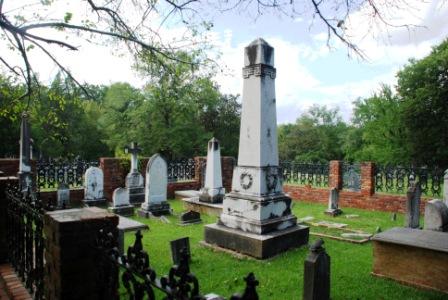
Willowbrook
Cemetery. Sometimes known as the Edgefield Village Cemetery, Willowbrook dates back to as early as 1819.
It is believed that the first person buried here was Pierre LaBorde, Edgefield’s first merchant, who died in 1819.
Although it is adjacent to the Baptist Church, the cemetery predates the church which was built in 1823. Many famous
South Carolinians are buried here, including four of our state’s governors (Francis W. Pickens, John Gary Evans, John
C. Sheppard, and Strom Thurmond), two of our United States Senators (M.C. Butler and Strom Thurmond), a famous congressman
(Preston S. Brooks), a remarkably accomplished missionary to China (Dr. John Lake), the author of the South Carolina Ordinance
of Secession (Francis Hugh Wardlaw), a Revolutionary veteran and approximately 150 Confederate veterans. Of special
interest is a large rock brought here from the Tai Kam Leper Colony in the South China Sea to mark the grave of Dr. John Lake
who founded the Colony.
|
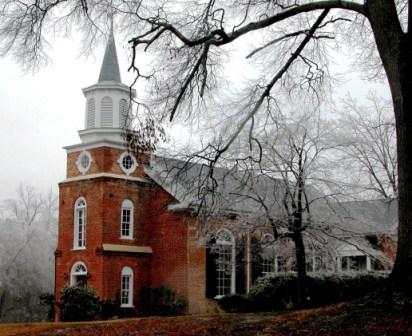
Trinity
Episcopal Church. This church was organized in 1835 and the building was completed in 1836. It was a
classical building with Palladian windows and a portico on the front. In 1886 the Victorian church tower was built,
eliminating the original portico. Unfortunately no photographs or descriptions of the original portico have survived.
In 1951 the upper portion of the tower was replaced by the present steeple. Among the original leaders of the church
were Whitfield Brooks and his wife, Mary Parsons Carroll Brooks, James Parsons Carroll, Francis Pickens, Andrew Pickens Butler,
Francis Hugh Wardlaw and Edmund B. Bacon. Significant memorials in the church include stained glass windows to Edward
Tabb Walker, a longtime rector, and James T. Bacon, longtime newspaper editor and organist at the church, marble tablets to
Whitfield Brooks, prominent lawyer and planter, Whitfield Butler Brooks, a valiant soldier who died in the War with Mexico,
and Francis Butler Simkins, one of the greatest Southern historians of all time, and a baptismal font to the daughters of
James Parsons Carroll.
|
|
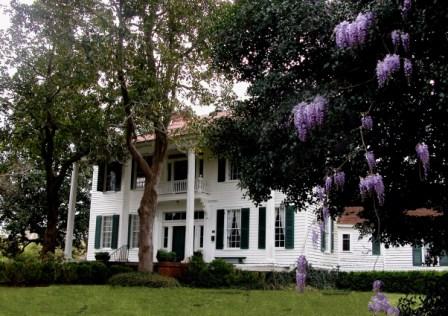
Magnolia Dale.
This home was built on the site of the first residence in Edgefield, built by Peter Youngblood and dating from approximately
1762. The property was later the home of Erasmus J. Youngblood who sold it in 1843 to Samuel Brooks of Connecticut.
It is thought that Brooks built the present house as early as 1843. In 1873 Brooks’ daughter sold the property
to Alfred J. Norris, a prominent lawyer and businessman. In 1875 his daughter, Mamie Norris, was born here. She
later married James Hammond Tillman who became Lieutenant Governor of South Carolina. After her husband’s and
her parents’ deaths, Mrs. Tillman continued to reside here. In 1929 the house was sold to the Kendall Company,
but Mrs. Tillman continued to live here and in 1959 she prevailed upon the Company to give the property to the Edgefield County
Historical Society. Today the house is the headquarters of the Society and is open by appointment as a house museum.
Interesting artifacts in the house include portraits of Arthur Simkins (1742-1826), his wife Margaret Dalby, Edmund Bacon
(1776-1826), his wife Eliza Fox, and the daughters of Francis Pickens, a sideboard belonging to Governor George McDuffie,
the dining room table of Governor and Senator Benjamin Ryan Tillman and many interesting items in the Strom Thurmond Room.
|
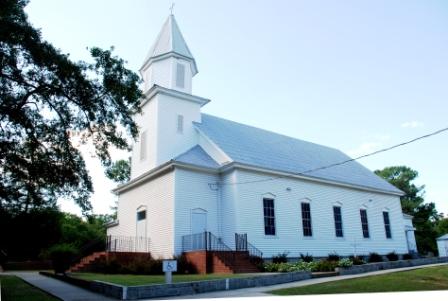
Macedonia Baptist Church. Formed in
the years right after the War Between the States when both blacks and whites were choosing to create separate churches for
each race, Macedonia was built on four acres purchased from Mrs. Rebecca Bland in 1869. Its founding members had primarily
been members of the Edgefield Village Baptist Church (now First Baptist) and included Peter Johnson, Paris Simkins, Andrew
Simkins, Laurence Cain, George Simkins and Robert A. Green. The present church building was completed in 1901.
The cemetery behind the church contains the graves of many remarkable members, including Katie Ramey, whose white husband,
W.D. Ramey is buried in Willowbrook Cemetery near the First Baptist Church and Paris Simkins, the son of Arthur Simkins, the
longtime editor of the Edgefield Advertiser.
|
 |
|
|
|
|
|